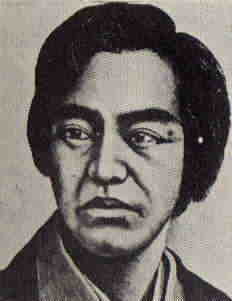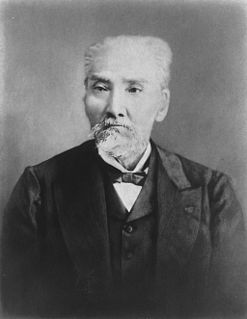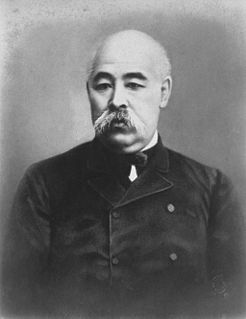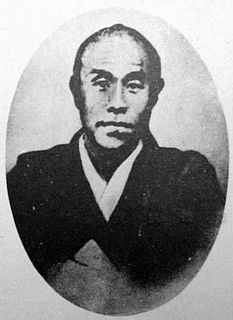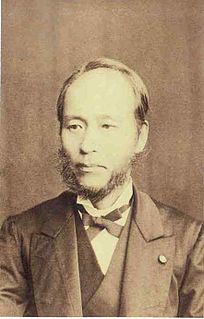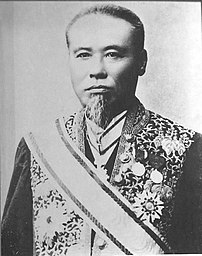The Osaka Conference of 1875(大阪会議Osaka Kaigi) was a meeting held by the major leaders of the Meiji Restoration in Osaka, Japan from January-February 1875 to address the issue of forming a representative assembly.
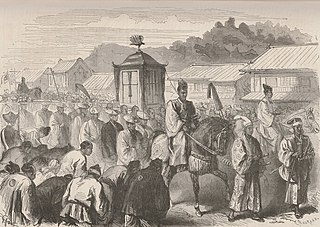
The Meiji Restoration, also known as the Meiji Renovation, Revolution, Reform, or Renewal, was an event that restored practical imperial rule to the Empire of Japan in 1868 under Emperor Meiji. Although there were ruling emperors before the Meiji Restoration, the events restored practical abilities and consolidated the political system under the emperor of Japan.

Osaka is a designated city in the Kansai region of Japan. It is the capital city of Osaka Prefecture and the largest component of the Keihanshin Metropolitan Area, the second largest metropolitan area in Japan and among the largest in the world with over 19 million inhabitants. Osaka will host Expo 2025. The current mayor of Osaka is Ichiro Matsui.

Japan is an island country in East Asia. Located in the Pacific Ocean, it lies off the eastern coast of the Asian continent and stretches from the Sea of Okhotsk in the north to the East China Sea and the Philippine Sea in the south.
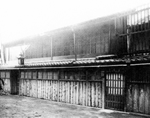
The leaders present included Okubo Toshimichi, Kido Takayoshi, Itagaki Taisuke, Ito Hirobumi, and Inoue Kaoru. In 1873, Itagaki had withdrawn from the government over the Seikanron issue, and was now loudly agitating for representative democracy as the leader of the Freedom and People's Rights Movement. Likewise, in 1874, Kido had withdrawn from the government due to his opposition to the Taiwan Expedition of 1874.
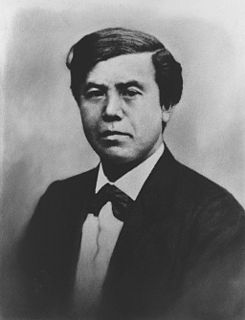
Kido Takayoshi, also referred to as Kido Kōin, was a Japanese statesman of the Meiji Restoration. He was known as Katsura Kogorō during the late Tokugawa period. He is considered as one of the three great nobles who led the Restoration.

CountItagaki Taisuke was a Japanese soldier, politician and leader of the Freedom and People's Rights Movement, which evolved into Japan's first political party. His image is on Japan's 1953 100-yen banknote.
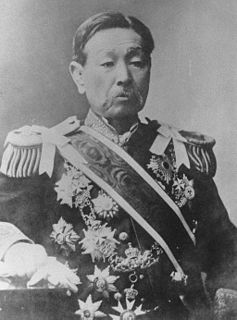
The Marquis Inoue Kaoru, GCMG was a Japanese politician and a prominent member of the Meiji oligarchy during the Meiji period of the Empire of Japan. As one of the senior statesmen in Japan during that period, he had a tremendous influence on the selection of the nation's leaders and formation of its policies.
The remaining Meiji oligarchs called for a meeting in Osaka in early 1873 in an attempt to reconcile differences and to persuade Itagaki and Kido to return to the government. As concessions, it was agreed that a Senate (Genrōin) would be established, along with an Assembly of Prefectural Governors. A new Supreme Court, called the Great Court of Cassation (Daishin-in) would also be established to separate the judiciary from the legislative branches of government.
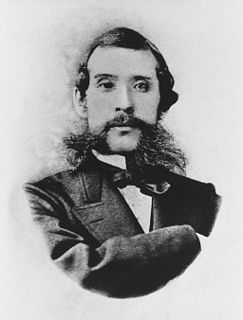
The Meiji oligarchy was the new ruling class of Meiji period Japan. In Japanese, the Meiji oligarchy is called the domain clique.

Chamber of Elders was a national assembly in early Meiji Japan, established after the Osaka Conference of 1875. It is also referred to as the Senate of Japan, Genrōin being the word used to describe the Roman Senate, and other western legislatures named after it.
The decisions reached at the Osaka Conference were officially sanctioned by an Imperial Proclamation in April 1875.
Although on the surface, the oligarchs appeared to be creating a form of representative assembly, the Genrōin and the Assembly of Prefectural Governors were appointive rather than elective, and were dominated by conservative bureaucrats, and in the same year, the first of the Peace Preservation Laws were enacted to suppress the liberal movement.

The Public Security Preservation Laws, commonly referred to as the Peace Preservation Laws, were a series of laws enacted from 1894 to 1925 during the Empire of Japan. Collectively, the laws were designed to suppress political dissent.


